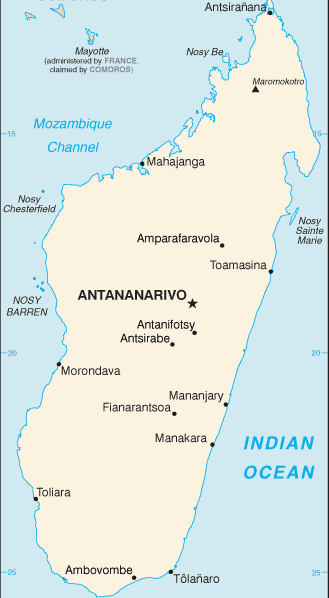Africa > Madagascar: Weather, Map, Costs and Travel Guide

Madagascar : When and where to go?
Click on a city for complete climate and weather tables
| Town | Jan | Feb | Mar | Apr | May | June | July | Aug | Sept | Oct | Nov | Dec |
| Antananarivo |  |  |  |  |  |  |  |  |  |  |  |  |
Madagascar: Climate & Weather
The Malagasy climate is characterised by a dry season from April to October and a wet season from November to March. However there are notable variations according to the different areas. There is more humidity in the East which experiences a shorter dry season and, on the contrary, a hotter and longer dry season characterises the South.
Cyclones can occur between November and March. The best time to visit Madagascar is therefore during the dry season, but avoiding the east during the months between June and September when it often experiences heavy rainfall.
Weather today

Light Rain
Wind: 4 km/h
Precipitation forecast: 4,5 mm
> Full report and 7-days forecast
Data updated at 14:42 (local time)
At that time, the weather was:
 22 °C / Mostly Cloudy
22 °C / Mostly Cloudy
Madagascar: Map

Sponsored links
What to do in Madagascar
The capital, Antananarivo, is composed of twelve hills. You can visit the Andravoahangy market and watch the craftsmen at work, take a relaxing walk in the Botanical and Zoological Park or go to the lively ‘Ville-haute’.
The Tsingy de Bemahara Reserve is an immense protected site with rock formations in the form of needles and stunning landscapes, it is definitely worth a visit.
Santa Maria Island offers a peaceful haven with its coconut palms and white sand, warm waters where you can enjoy diving and maybe see some humpback whales who often visit the island in the summer.
Ranomafana National Park boasts a great number of species of animals and plants including lemurs, birds, chameleons and makis surrounded by orchids and giant bamboo so creating a truly tropical paradise.
Fort Dauphin, in the extreme south-east will give you the sensation of standing at the end of the world with its columned houses and varied landscapes where rich vegetation can be found next to desert like countryside.
Hiking enthusiasts will enjoy exploring Isalo National Park and exploring its relief with its strange shapes and the canyons , crystal clear torrents of water and wildlife such as crocodiles and giant bats amongst others.
Madagascar: The basics
A visa is required.
The currency in circulation is the Malagasy ariary.
The budget required for food and lodging is fairly modest, a good, often excellent meal will generally cost less than €10, and even less in the local roadside food stalls which often have very tasty food. A double room will only cost around €15.
Concerning health precautions it is recommended that you take a basic first aid kit. Wash your hands thoroughly before handling food and peel fruit and vegetables. Follow an anti-malaria course of treatment and protect yourself against mosquitoes. Do not drink tap water. Finally, make sure your diphtheria, tetanus and polio vaccinations are up to date and those for typhoid and hepatitis A and B are recommended.
The collective taxi is the only readily available means of getting around the country apart from renting a car which can be quite expensive.
Souvenir ideas for friends and family include inlaid work, silver bracelets, lace, spices, cotton items and the various raffia objects.



